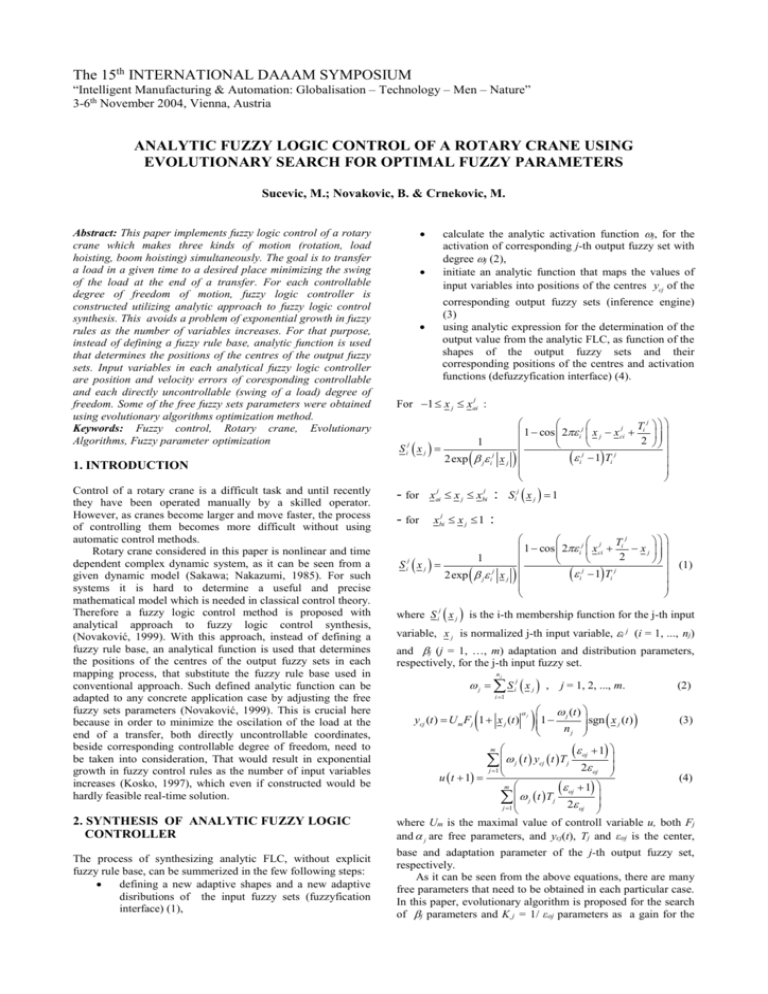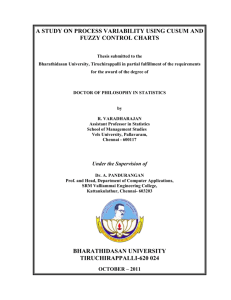The 15th INTERNATIONAL DAAAM SYMPOSIUM
advertisement

The 15th INTERNATIONAL DAAAM SYMPOSIUM “Intelligent Manufacturing & Automation: Globalisation – Technology – Men – Nature” 3-6th November 2004, Vienna, Austria ANALYTIC FUZZY LOGIC CONTROL OF A ROTARY CRANE USING EVOLUTIONARY SEARCH FOR OPTIMAL FUZZY PARAMETERS Sucevic, M.; Novakovic, B. & Crnekovic, M. Abstract: This paper implements fuzzy logic control of a rotary crane which makes three kinds of motion (rotation, load hoisting, boom hoisting) simultaneously. The goal is to transfer a load in a given time to a desired place minimizing the swing of the load at the end of a transfer. For each controllable degree of freedom of motion, fuzzy logic controller is constructed utilizing analytic approach to fuzzy logic control synthesis. This avoids a problem of exponential growth in fuzzy rules as the number of variables increases. For that purpose, instead of defining a fuzzy rule base, analytic function is used that determines the positions of the centres of the output fuzzy sets. Input variables in each analytical fuzzy logic controller are position and velocity errors of coresponding controllable and each directly uncontrollable (swing of a load) degree of freedom. Some of the free fuzzy sets parameters were obtained using evolutionary algorithms optimization method. Keywords: Fuzzy control, Rotary crane, Evolutionary Algorithms, Fuzzy parameter optimization calculate the analytic activation function j, for the activation of corresponding j-th output fuzzy set with degree j (2), initiate an analytic function that maps the values of input variables into positions of the centres ycj of the corresponding output fuzzy sets (inference engine) (3) using analytic expression for the determination of the output value from the analytic FLC, as function of the shapes of the output fuzzy sets and their corresponding positions of the centres and activation functions (defuzzyfication interface) (4). For 1 x j xai : j Si x j j 1. INTRODUCTION Control of a rotary crane is a difficult task and until recently they have been operated manually by a skilled operator. However, as cranes become larger and move faster, the process of controlling them becomes more difficult without using automatic control methods. Rotary crane considered in this paper is nonlinear and time dependent complex dynamic system, as it can be seen from a given dynamic model (Sakawa; Nakazumi, 1985). For such systems it is hard to determine a useful and precise mathematical model which is needed in classical control theory. Therefore a fuzzy logic control method is proposed with analytical approach to fuzzy logic control synthesis, (Novaković, 1999). With this approach, instead of defining a fuzzy rule base, an analytical function is used that determines the positions of the centres of the output fuzzy sets in each mapping process, that substitute the fuzzy rule base used in conventional approach. Such defined analytic function can be adapted to any concrete application case by adjusting the free fuzzy sets parameters (Novaković, 1999). This is crucial here because in order to minimize the oscilation of the load at the end of a transfer, both directly uncontrollable coordinates, beside corresponding controllable degree of freedom, need to be taken into consideration, That would result in exponential growth in fuzzy control rules as the number of input variables increases (Kosko, 1997), which even if constructed would be hardly feasible real-time solution. 2. SYNTHESIS OF ANALYTIC FUZZY LOGIC CONTROLLER The process of synthesizing analytic FLC, without explicit fuzzy rule base, can be summerized in the few following steps: defining a new adaptive shapes and a new adaptive disributions of the input fuzzy sets (fuzzyfication interface) (1), 1 2exp j i j x j - for xai x j xbi - for xbi x j 1 j j j Si x j j Tj j j 1 cos 2 i x j x ci i 2 j j 1 T i i Si j x j 1 : : 1 2exp j i j x j Tj j j 1 cos 2 i x ci i x j 2 j j (1) 1 T i i where S i x j is the i-th membership function for the j-th input j variable, x j is normalized j-th input variable, i j (i = 1, ..., nj) and j (j = 1, …, m) adaptation and distribution parameters, respectively, for the j-th input fuzzy set. nj j S ij x j , j = 1, 2, ..., m. (2) i 1 ycj (t ) U m Fj 1 x j (t ) j 1 n(t) sgn x (t) j j (3) j 1 2 oj j 1 (4) u t 1 m oj 1 j t Tj 2 oj j 1 where Um is the maximal value of controll variable u, both Fj and j are free parameters, and ycj(t), Tj and εoj is the center, m t y t T j cj oj j base and adaptation parameter of the j-th output fuzzy set, respectively. As it can be seen from the above equations, there are many free parameters that need to be obtained in each particular case. In this paper, evolutionary algorithm is proposed for the search of j parameters and K¸j = 1/ εoj parameters as a gain for the output fuzzy sets, while others were obtained from a previous computer simulation. Simulated evolution is a powerfull, stohastic, robust optimization tool, that is capable of finding global optimum solution utilizing the mechanics of genetics and Darwinian natural selection. For our problem, we used real-valued variables (parameters) encoding (phenotypes) into the gene strings, rather then binary encoding (genotypes). Although some mathematical results showed that there is no best choice of representation for every individual problem (Fogel, 2000), the use of real-valued genes in EAs is claimed to offer a number of advantages in function optimization over binary encodings (Wright, 1991). Efficiency of the EA is increased as there is no need to convert chromosomes to phenotypes before each function evaluation. Also, less memory is required as efficient floating-point internal computer representations can be used directly. There is no loss in precision by discretization to binary or other values and there is greater freedom to use different genetic operators. For some problem domains, it is argued that the binary representation is in fact deceptive in that it obscures the nature of the search (Bramlette, 1991). In order to assess the fitness of the population for selection, performance index is introduced as I wq1 q 1 / nN wq q (5) Fig. 1. Nominal (--) and achieved (-) trajectories where wq1 and wq are scaling factors, n is the number of degrees of freedom and N is the number of time intervals while q 1 qi t j t j N n (6) j 1 i 1 q Fig. 2. Positions (-) and velocity (--) errors max qi t j (7) i, j are L1 and Chebyshev ( L ) norm, where qi t j is position error of the i-th link in time interval tj. For generating new offsprings, crossover operator (discrete recombination) is used combined with mutation in order to decrease probability of local minimum entrapment. 3. COMPUTER SIMULATION Rotary crane was run in a MATLAB software environment. The data used for computer simulation were taken from a real rotary crane made by Komatsu Ltd (Sakawa; Nakazumi, 1985). For solving a differential equations, second order RungeKutta method was employed with fixed stepsize. Torque saturation was also taken into consideration so that torque of each actuator does not exceed ist maximal value. Initial parameters used in simulation are given in Table 1. DOF ζ (T) ξ (T) η (T) Start. posit.[rad,m] -1.5 π/3 (R) φ3 (R) -π -17.45 0 Final posit.[rad, m] 14 π/6 0 10.5 0 Profile of velocity Trapez. Trapez. Trapez. – – Start. time point [s] 0 0 0 0 0 Final time point [s] 16 16 16 16 16 Sampling period [s] 0.02 0.02 0.02 0.02 0.02 Expected max. 0.2 0.1 0.1 3 3 posit. error [rad, m] Expected max. vel. 0.5 0.05 0.1 1.5 2 error [rad/s, m/s] Table 1. Initial parameters used in fuzzy-control synthesis The results of the simulation are shown in Fig. 1 which displays position tracking errors and Fig. 2 that shows position and velocity errors of controllable coordinates and swing of the load. It can be seen that after the initial oscillation, which is the result of system dynamics (inertial forces), swing of the load decays quickly as approaches to the final state, resulting in almost zero oscillations at the final time of the transfer. 4. CONCLUSION As results showed, proposed control scheme was successfully applied in terms of tracking the nominal positions and damping a load oscillations at the end of the transfering process. Taken into consideration that the control algorithm is not too demanding in terms of processing time needed, proposed control scheme could be implemented on a real rotary crane to test its feasibility, by installing a micro-computer. On the other hand, evolutionary computation provided a convenient way for finding optimal free fuzzy parameters. Future improvement of work would be to include also the other free fuzzy parameters into optimization scheme which could be multiobjective, taken into consideration energy consumption. 5. REFERENCE Sakawa, Y.; Nakazumi, A. (1985), Modeling and Control of a Rotary Crane, Journal of Dynamic Systems, Measurement and Control, Vol. 107, p.200 – 206. Novakovic, B. (1999), Fuzzy Logic Control Synthesis Without Any Rule Base, IEEE Trans. on Systems, Man, and Cybernetics, Vol.29, No. 3, pp. 459 – 466. Kosko, B. (1997), Fuzzy Engineering, Prentice Hall, Upper Saddle River, NJ. Fogel, B. D. (2000), Evolutionary Computation, Principles and Practice for Signal Processing, SPIE Press, ISBN 0-81943725-5. Wright, A. H. (1991), Genetic Algorithms for Real Parameter Optimization, Foundations of Genetic Algorithms, J. E. Rawlins (Ed.), Morgan Kaufmann, pp. 205-218. Bramlette, M. F. (1991), Initialization, Mutation and Selection Methods in Genetic Algorithms for Function Optimization, Proc ICGA 4, pp. 100-107.






